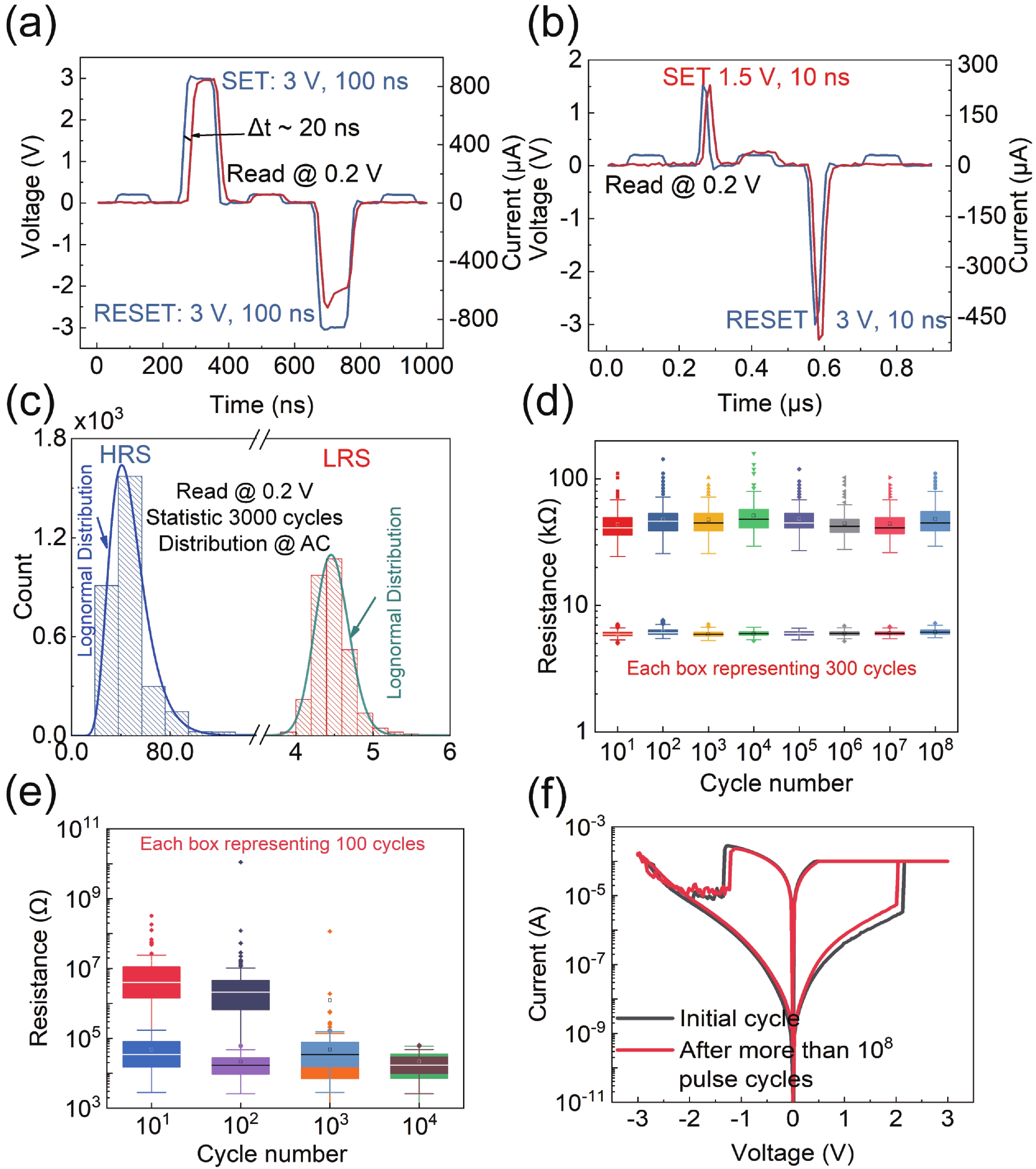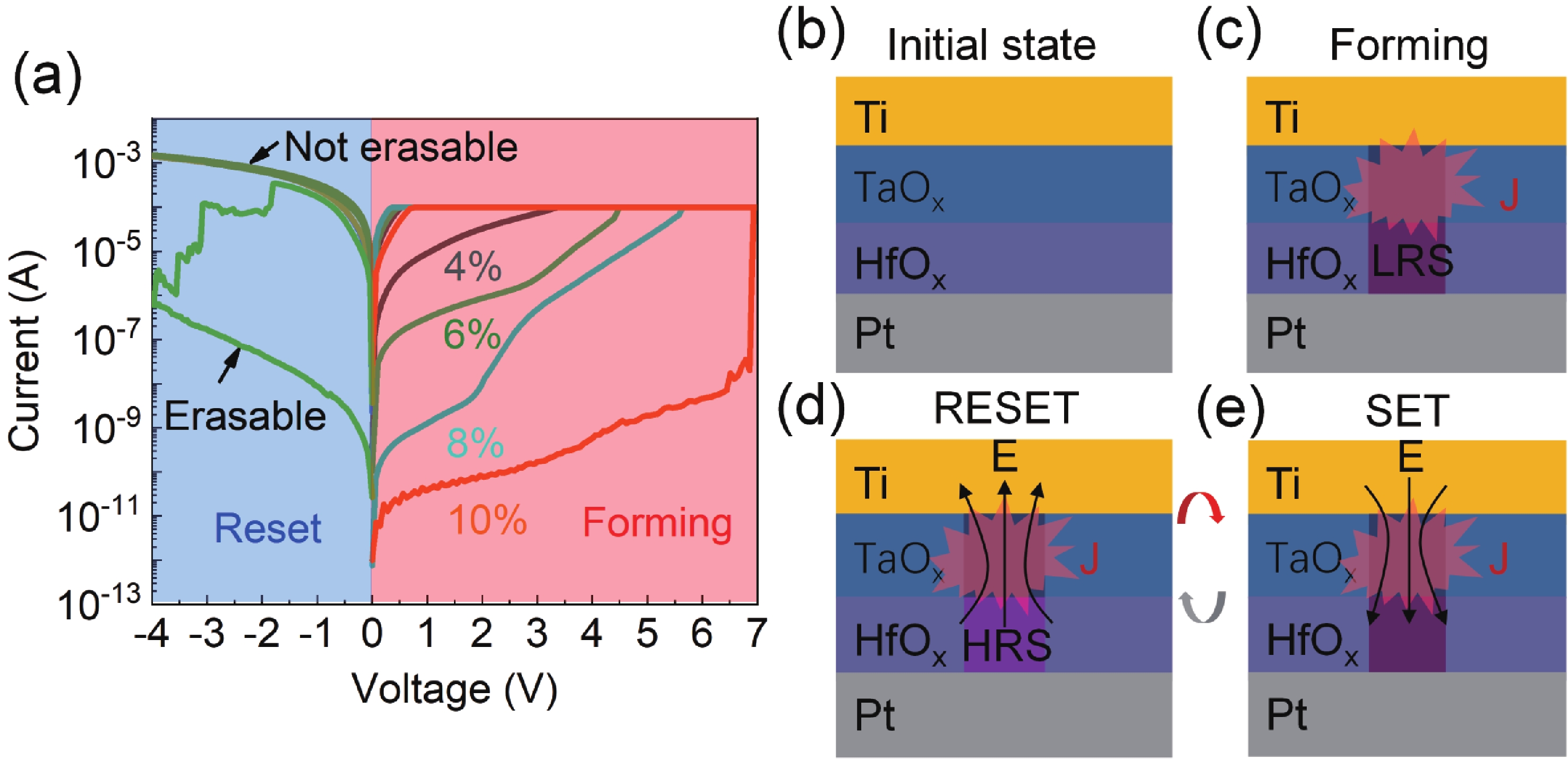| Citation: |
Yunxia Hao, Ying Zhang, Zuheng Wu, Xumeng Zhang, Tuo Shi, Yongzhou Wang, Jiaxue Zhu, Rui Wang, Yan Wang, Qi Liu. Uniform, fast, and reliable CMOS compatible resistive switching memory[J]. Journal of Semiconductors, 2022, 43(5): 054102. doi: 10.1088/1674-4926/43/5/054102
****
Y X Hao, Y Zhang, Z H Wu, X M Zhang, T Shi, Y Z Wang, J X Zhu, R Wang, Y Wang, Q Liu. Uniform, fast, and reliable CMOS compatible resistive switching memory[J]. J. Semicond, 2022, 43(5): 054102. doi: 10.1088/1674-4926/43/5/054102
|
Uniform, fast, and reliable CMOS compatible resistive switching memory
DOI: 10.1088/1674-4926/43/5/054102
More Information
-
Abstract
Resistive switching random access memory (RRAM) is considered as one of the potential candidates for next-generation memory. However, obtaining an RRAM device with comprehensively excellent performance, such as high retention and endurance, low variations, as well as CMOS compatibility, etc., is still an open question. In this work, we introduce an insert TaOx layer into HfOx-based RRAM to optimize the device performance. Attributing to robust filament formed in the TaOx layer by a forming operation, the local-field and thermal enhanced effect and interface modulation has been implemented simultaneously. Consequently, the RRAM device features large windows (> 103), fast switching speed (~ 10 ns), steady retention (> 72 h), high endurance (> 108 cycles), and excellent uniformity of both cycle-to-cycle and device-to-device. These results indicate that inserting the TaOx layer can significantly improve HfOx-based device performance, providing a constructive approach for the practical application of RRAM. -
References
[1] Shi T, Wang R, Wu Z H, et al. A review of resistive switching devices: Performance improvement, characterization, and applications. Small Struct, 2021, 2, 2170010 doi: 10.1002/sstr.202170010[2] Wang Z R, Wu H Q, Burr G W, et al. Resistive switching materials for information processing. Nat Rev Mater, 2020, 5, 173 doi: 10.1038/s41578-019-0159-3[3] Li X K, Zhang B T, Wang B W, et al. Low power and high uniformity of HfO x-based RRAM via tip-enhanced electric fields. Sci China Inf Sci, 2019, 62, 1 doi: 10.1007/s11432-019-9910-x[4] Zhao X L, Zhang X M, Shang D S, et al. Uniform, fast, and reliable LixSiOy-based resistive switching memory. IEEE Electron Device Lett, 2019, 40, 554 doi: 10.1109/LED.2019.2900261[5] Chen F T, Lee H Y, Chen Y S, et al. Resistance switching for RRAM applications. Sci China Inf Sci, 2011, 54, 1073 doi: 10.1007/s11432-011-4217-8[6] Han R Z, Huang P, Zhao Y D, et al. Efficient evaluation model including interconnect resistance effect for large scale RRAM crossbar array matrix computing. Sci China Inf Sci, 2018, 62, 1 doi: 10.1007/s11432-018-9555-8[7] Xia Q F, Yang J J. Memristive crossbar arrays for brain-inspired computing. Nat Mater, 2019, 18, 309 doi: 10.1038/s41563-019-0291-x[8] Wu Z, Lu J, Shi T, et al. A habituation sensory nervous system with memristors. Adv Mater, 2020, 32, e2004398 doi: 10.1002/adma.202004398[9] Wu Z H, Zhao X L, Yang Y, et al. Transformation of threshold volatile switching to quantum point contact originated nonvolatile switching in graphene interface controlled memory devices. Nanoscale Adv, 2019, 1, 3753 doi: 10.1039/C9NA00409B[10] Kim H J, Park T H, Yoon K J, et al. Fabrication of a Cu-cone-shaped cation source inserted conductive bridge random access memory and its improved switching reliability. Adv Funct Mater, 2019, 29, 1806278 doi: 10.1002/adfm.201806278[11] Lu Y F, Li Y, Li H Y, et al. Low-power artificial neurons based on Ag/TiN/HfAlO x/Pt threshold switching memristor for neuromorphic computing. IEEE Electron Device Lett, 2020, 41, 1245 doi: 10.1109/LED.2020.3006581[12] Sebastian A, le Gallo M, Khaddam-Aljameh R, et al. Memory devices and applications for in-memory computing. Nat Nanotechnol, 2020, 15, 529 doi: 10.1038/s41565-020-0655-z[13] Li H T, Wu T F, Mitra S, et al. Device-architecture co-design for hyperdimensional computing with 3d vertical resistive switching random access memory (3D VRRAM). 2017 International Symposium on VLSI Technology, Systems and Application, 2017, 1[14] Liu Q, Long S, Lv H, et al. Controllable growth of nanoscale conductive filaments in solid-electrolyte-based ReRAM by using a metal nanocrystal covered bottom electrode. ACS Nano, 2010, 4, 6162 doi: 10.1021/nn1017582[15] Li S S, Su Y K. Improvement of the performance in Cr-doped ZnO memory devices via control of oxygen defects. RSC Adv, 2019, 9, 2941 doi: 10.1039/C8RA10112D[16] Zhang Y Z, Huang P, Gao B, et al. Oxide-based filamentary RRAM for deep learning. J Phys D, 2021, 54, 083002 doi: 10.1088/1361-6463/abc5e7[17] Liu L, Xiong W, Liu Y X, et al. Designing high-performance storage in HfO2/BiFeO3 memristor for artificial synapse applications. Adv Electron Mater, 2020, 6, 1901012 doi: 10.1002/aelm.201901012[18] Park J H, Jeon D S, Kim T G. Improved uniformity in the switching characteristics of ZnO-based memristors using Ti sub-oxide layers. J Phys D, 2017, 50, 015104 doi: 10.1088/1361-6463/50/1/015104[19] Hao Z Q, Gao B, Xu M H, et al. Cryogenic HfO x-based resistive memory with a thermal enhancement capping layer. IEEE Electron Device Lett, 2021, 42, 1276 doi: 10.1109/LED.2021.3099725[20] Wu W, Wu H Q, Gao B, et al. Improving analog switching in HfO x-based resistive memory with a thermal enhanced layer. IEEE Electron Device Lett, 2017, 38, 1019 doi: 10.1109/LED.2017.2719161[21] Ryu H, Kim S. Pseudo-interface switching of a two-terminal TaO x/HfO2 synaptic device for neuromorphic applications. Nanomaterials, 2020, 10, 1550 doi: 10.3390/nano10081550[22] Yoon J H, Kwon D E, Kim Y, et al. The Current limit and self-rectification functionalities in the TiO2/HfO2 resistive switching material system. Nanoscale, 2017, 9, 11920 doi: 10.1039/C7NR02215H[23] Wedig A, Luebben M, Cho D Y, et al. Nanoscale cation motion in TaO x, HfO x and TiO x memristive systems. Nat Nanotech, 2016, 11, 67 doi: 10.1038/nnano.2015.221[24] Landon C D, Wilke R H T, Brumbach M T, et al. Erratum: “Thermal transport in tantalum oxide films for memristive applications. Appl Phys Lett, 2015, 107, 059902 doi: 10.1063/1.4928532[25] Zhang Y, Mao G Q, Zhao X L, et al. Evolution of the conductive filament system in HfO2-based memristors observed by direct atomic-scale imaging. Nat Commun, 2021, 12, 7232 doi: 10.1038/s41467-021-27575-z[26] Yin J, Zeng F, Wan Q, et al. Adaptive crystallite kinetics in homogenous bilayer oxide memristor for emulating diverse synaptic plasticity. Adv Funct Mater, 2018, 28, 1706927 doi: 10.1002/adfm.201706927[27] Miao F, Strachan J P, Yang J J, et al. Anatomy of a nanoscale conduction channel reveals the mechanism of a high-performance memristor. Adv Mater, 2011, 23, 5633 doi: 10.1002/adma.201103379 -
Proportional views






 DownLoad:
DownLoad:

















